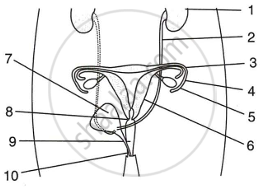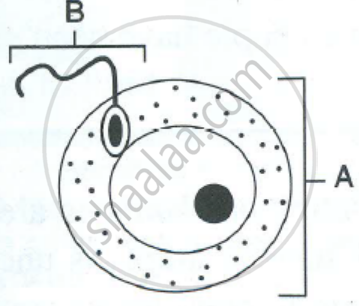Advertisements
Advertisements
Question
“Gender of child is determined by the male partner of couple”. Draw a diagram explaining the above statement.
Solution
1). The chromosome number in germ cells producing the gametes are diploid i.e. 2n. It includes 22 pairs of autosomes and 1 pair of sex-chromosomes i.e. (44 + XX or 44 + XY).
2). These germ cells divide by meiosis.
3). Due to this, gametes contain only haploid (n) number of chromosomes i.e. (22 + X or 22 + Y).
4). Two types of sperms are produces as (22 + X) or (22 + Y) whereas oocytes are produced of only one type as (22 + X).
5). Both, sperms and oocytes are produced by meiosis.
6). In case of sperms, process of meiotic division is completed before the sperms leave male reproductive tract.
7). However, in case of oocytes, process of meiotic division completes after ovulation; during fertilization in oviduct.
APPEARS IN
RELATED QUESTIONS
Write the functions of the following organs of reproduction:
a. Ovaries
b. Seminal vesicle and prostate glands
What is placenta?
State the changes that take place in the uterus when Implantation of embryo has occurred
Newly formed DNA copies may not be identical at times. Give one reason.
Why are testes located outside the abdominal cavity? What is responsible for bringing about changes in appearance seen in boys at the time of puberty?
Give appropriate biological/technical terms for the following:
The kind of twins formed from two fertilized eggs.
Differentiate between Sperm duct and fallopian rube (function)
The site of maturation of human sperms is the
For how much time does menstruation last in human females (or women)?
Write the names of female sex hormones.
Why is it an advantage for the testes to be situated in the scrotal sac outside the main body cavity? Can you think of one disadvantage?
Which structure in human female is equivalent to the testes in the male?and in what respect the structures are equivalent?
What is meant by implantation?
What joins embryo to placenta in mother's body?
The male gametes in a flower and in a human are produced respectively in :
(a) stigma and ovary
(b) anther and style
(c) ovary and testes
(d) anther and testes
The normal body cell of an organism contains 28 pairs of chromosomes. The number of chromosomes present in its germ cell will be
(a) 28
(b) 14
(c) 56
(d) 42
Given below is a diagram of two systems together in the human body.
 |
- Name the systems.
- Name the parts numbered 1-10.
- Describe the functions of the parts 3, 4, 5 & 6.
- What will happen if the part 3 on both sides gets blocked?
The diagram below represents two reproductive cells A and B. Study the same and then answer the questions that follow:
 |
- Identify the reproductive cells A and B.
- Name the specific part of the reproductive system where the above cells are produced.
- Where in the female reproductive system do these cells unite?
- Name the main hormones secreted by the (1) ovary (2) testes.
- Name an accessory gland found in the male reproductive system and state the function of its secretion.
Explain how the transmission of virus and bacteria diseases be prevented?
Write the functions of secretions of prostate gland and seminal vesicles in humans.
Draw a sectional view of human female reproductive system and label the following parts :
(i) Where the development of egg occurs.
(ii) Where fertilization takes place.
Describe in brief the role of prostate gland in human male reproductive system.
List two changes observed in girls at the time of puberty.
Give appropriate term of the following:
The onset of reproductive phase in a young female.
Choose the correct answer:
The aim of sexual reproduction _________
Give the functions of the following:
Vagina
Define the following:
Implantation
What are the signs of puberty in human males and females?
Name the Following
What does this abbreviation stand for FSH?
Name the Following
What does this abbreviation stand for IUD?
Choose the Odd One Out:
Choose the Odd One Out:
Correct sequence in development is ______.
Cryptorchidism is a condition where ______.
Testosterone is produced by:
Mention any two changes that are common to both boys and girls in early teenage years.
